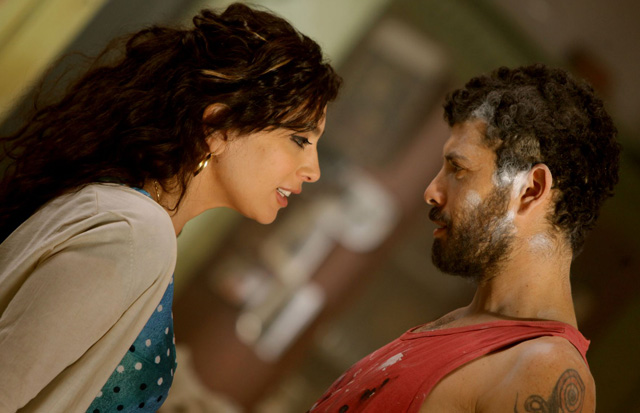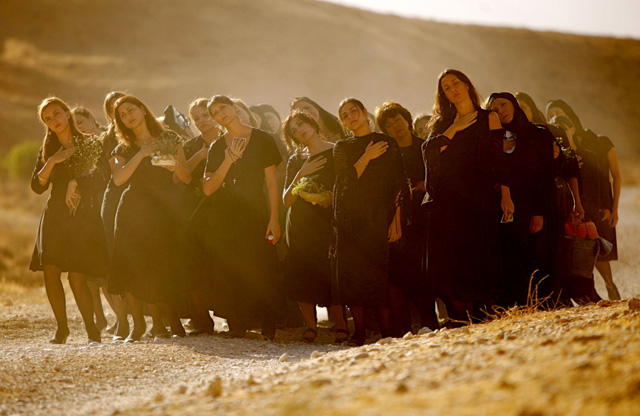CHICAGO – Patrick McDonald of HollywoodChicago.com appears on “The Morning Mess” with Dan Baker on WBGR-FM (Monroe, Wisconsin) on March 21st, 2024, reviewing the new streaming series “Manhunt” – based on the bestseller by James L. Swanson – currently streaming on Apple TV+.
‘Where Do We Go Now?’ Advances a Path Toward Peace
 Rating: 4.0/5.0 |
CHICAGO – Society constantly needs a reminder about itself, especially in the arena of political and religious conflict. “Where Do We Go Now?,” written and directed with creative delicacy by Nadine Labaki, provides that reminder and fashions an adult fable of how women can do their part to stop war.
Labaki uses musical numbers, extreme portrayals of Lebanese townspeople and a troupe of Russian belly dancers to highlight the absurdity of the petty bickering that lead to larger wars, mixed with the ingenuity of the matriarchy to quiet the storm. The narrative is a fascinating glimpse into another culture, but also expresses how similar we all are in such situations. The story communicates that no matter where we’re from, we do have a responsibility in keeping the peace, simply by paying attention to our role in any conflict. Choosing peace over war, even tricking people into it, seems much less deadly than capitulating to the inevitable violence.
The story is set in an Lebanese village, populated by nice people, some of whom happen to be Christian and happen to be Muslim. An example of a big event in the village is that someone has figured out a way to rig up an ancient TV, and the town gathers to watch as if they were in an outdoor cinema. As some reports start to filter in from the outside that Christians and Muslims are clashing, the women of the village intervene and cut off the television.
 Photo credit: Rudy Bou Chebel for Sony Pictures Classics |
But the genie is out of the bottle. Other incidences occur and it looks like tensions are mounting. Once the first fight breaks out, the women employ other means to distract the male testosterone overload, by recruiting a busload of Russian belly dancers. Ultimately, everything that is plotted and planned to keep the peace must come together, for the village to remain together. In the midst of it all, a couple of musical numbers break out, but that is to be expected in a peaceful village.
Outrageous? Yes. Effective? Well, it certainly gives legitimacy to the title question, and that’s worth the extra half star. There a bit too much thrown in, but once the rhythm is established it’s best to just hold on. Keep telling yourself it’s a fairy tale, a fable, a type of biblical yarn brought to life. There is no need to take anything literally, because suddenly a song breaks out or there is a Russian belly dancer Infiltrating the men’s war room. Once upon a time…
Director Labaki also has one of the key roles in the film, and she expresses the character with a saucy zest, especially singing a seduction song to her renovation contractor. All the actors in the piece besides Labaki are first-timers, and this adds to the authenticity in the make-up of the village, and makes the anger that felt more acute. The women who portray the Russian belly dancers are also quite good, as they become key elements in the fight for peace and have a fish-out-of-water comic sensibility compared to the villagers.
There are some stark abuses of religious iconography in the film, but it’s interesting to note that in keeping the peace throughout the crisis, those symbols of Muslim and Christian worship become less important than the people. And that is the moral lesson of the fable – we only have each other, and the way to a happy and successful life is peaceful co-existence. Easy and breezy, but harder in practice, especially with men, tempers and guns.
 Photo credit: Rudy Bou Chebel for Sony Pictures Classics |
It is women that scheme the path toward peace in the narrative, reminiscence of the ancient Aristophanes stage play, Lysistrata (women withhold sex to stop war). But instead of withholding anything near the conclusion, the women of the village pile on , creating a raucous air to distract both the male anger and the conflict. If there is anything to take away from the strategy, it’s that everybody – despite andy differences – loves a good party.
The question of the film is challenged through the fable, always looming above the village like some graffiti message spray painted everywhere. But to make the answer to the question as vague as the inquiry – there is a place to go, and the directive on the path towards that place is to keep going.
 | By PATRICK McDONALD |


